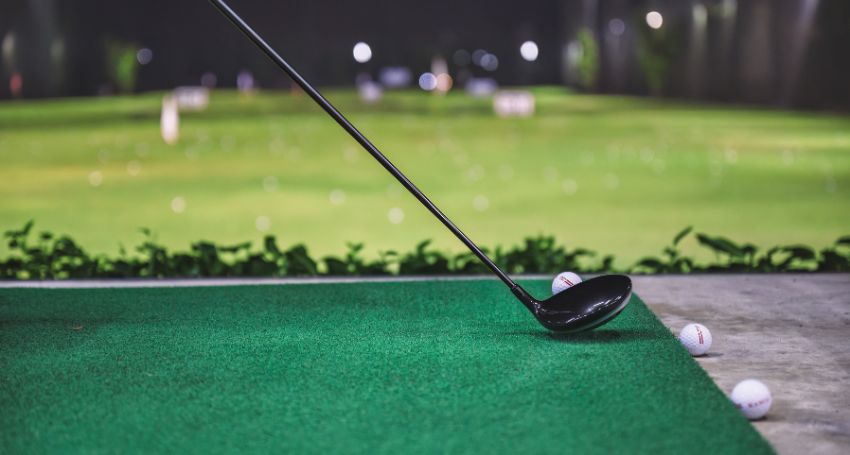Virtual golf has revolutionized how golf enthusiasts practice and play the golf game, offering the ability to enjoy the sport indoors using advanced golf simulator technology. However, a common question arises: How accurate is virtual golf compared to playing on a real course? With the help of launch monitors, high-speed cameras, and sensor technology, virtual golf can provide a realistic and immersive experience. This guide explores the factors that affect the accuracy of golf simulators, what you can expect from different models, and how closely they replicate the experience of playing on an actual golf course.
What Is Virtual Golf
Virtual golf uses golf simulators that combine launch monitors, high-speed cameras, and simulation software to recreate the experience of playing on a real golf course indoors. By tracking the ball and club data as you hit a shot, the simulator visually represents your shot on a screen.
- How It Works: When you hit the golf ball, the launch monitor captures critical data points like ball speed, launch angle, and spin rates. This information is used to simulate the ball flight on a virtual course.
- Golf Simulation: Advanced simulators, like Trackman and Skytrak, use infrared sensors and high-speed cameras to capture detailed information, creating a realistic golf simulation that closely mimics outdoor play.
How Do Golf Simulators Track Your Shots
The accuracy of golf simulators largely depends on how they track data. Different systems use varying technologies, such as infrared, radar, and optical sensors, to measure the movement of the golf ball and the clubhead.
- High-Speed Cameras: These cameras track the ball’s speed and launch angle by capturing the ball’s movement immediately after impact. This is often combined with infrared sensors for better accuracy.
- Radar Systems: Systems like Trackman use Doppler radar to measure the ball’s flight and provide precise information about how far and fast the ball travels.
- Launch Monitors: Devices like Foresight and GC2 use launch monitor technology to offer highly detailed data, making them ideal for players looking for precise feedback.
Read More: What Is Custom Club Fitting?
How Accurate Is a Golf Simulator’s Data
Golf simulators can be quite accurate, especially with high-end models, but it depends on the specific device and its setup. Most high-end simulators claim an accuracy rate of within 1-3% of real-life measurements, which can be sufficient for most players.
- Distance and Trajectory: Advanced simulators provide data on carry distance, total distance, and ball flight, offering a realistic representation of how the ball would behave outdoors.
- Spin and Launch Angle: Data such as launch angle and spin rates are critical for shot accuracy, and top-tier simulators like Trackman can measure these factors precisely, making them suitable for professional training.
Factors Affecting Golf Simulator Accuracy
Several elements influence the accuracy of data provided by a golf simulator, impacting how closely it replicates the conditions of real golf:
- Environmental Conditions: Factors like lighting and room dimensions can affect how well the simulator’s sensors track the ball. Poor lighting or limited space can lead to less accurate results.
- Quality of Sensors: The more advanced the infrared sensors and high-speed cameras, the more accurate data you can expect. Systems use high-end technology to provide more precise readings.
- Hitting Surface: The hitting surface plays a role in how the launch monitor captures data. A surface mimicking real turf provides more consistent results than a hard or uneven floor.
Virtual Golf Vs. Real Golf Conditions
While golf simulators can provide a highly realistic experience, there are some differences between playing indoors and on an actual course:
- Ball Flight and Carry Distance: High-end simulators can accurately simulate ball flight, showing how the ball would behave in the air. However, they may struggle to replicate outdoor environmental conditions like wind and temperature.
- Putting Challenges: Some simulators find it challenging to simulate the nuances of a putt, as it requires precise tracking of the ball’s movement on a flat surface. However, newer models have improved in this area, offering more realistic short-game practice.
Launch Monitors
The launch monitor is at the heart of a golf simulator’s ability to provide accurate results. It captures key metrics that determine the golf simulation’s accuracy.
- Trackman and Foresight: These top-tier launch monitors are known for their precision, making them popular choices among professionals. They use advanced technologies like Doppler radar to measure the clubhead speed, ball speed, and launch angle.
- Budget-Friendly Options: Devices like Skytrak offer a good balance between price and accuracy, making them a great option for amateur golfers looking to improve their game at home.
High-End Vs. Budget Golf Simulators
Depending on your needs and expectations, the difference in accuracy between high-end and budget golf simulators can be significant.
- High-End Simulators: These models, like Trackman and Foresight, are known for their accurate data, making them suitable for those seeking a precise golf experience. They can measure various metrics, including spin rates and launch angle.
- Budget Simulators: More affordable options may provide less accurate measurements, especially for advanced metrics like ball spin. However, they can still offer a valuable practice experience for recreational players.
Environment Impacts On the Accuracy
The setup and environment where you use a golf simulator can affect its accuracy:
- Space and Dimensions: A room with enough space for the simulator to properly track the golf ball is essential. You should have at least 10-12 feet of space for accurate readings.
- Proper Lighting: Good lighting helps the infrared sensors and high-speed cameras capture data accurately. Dim or inconsistent lighting can lead to less accurate tracking.
- Hitting Indoors: For the best results, the surface you use to hit the ball should mimic outdoor turf, helping the simulator replicate real conditions as closely as possible.
Read More: Types of Golf Shots
Golf Simulator for Maximum Accuracy
Proper setup is crucial for getting the most accurate readings from your golf simulator:
- Align the Launch Monitor: Ensure the launch monitor is aligned correctly with the hitting surface to capture precise data.
- Calibrate the Simulator: Calibration helps the simulator understand your golf swing style and environment, leading to more consistent and repeatable results.
- Follow Manufacturer Instructions: Different simulators have specific setup requirements. Following these instructions can help ensure your golf simulator provides accurate results.
FAQ’s
How Accurate Are High-End Golf Simulators Like Trackman?
High-end models like Trackman are known for their accurate results, often matching the conditions on a real golf course. They are considered pretty accurate for both professional and amateur golfers.
Can Budget Golf Simulators Improve My Game?
Yes, while they may not match the precision of high-end models, budget golf simulators can still provide valuable feedback and help you improve your game indoors.
What Are the Best Practices for Maximizing Simulator Accuracy?
Ensure accurate results, ensure your simulator is set up correctly, use a proper hitting surface, and maintain consistent lighting in your practice space.





























































